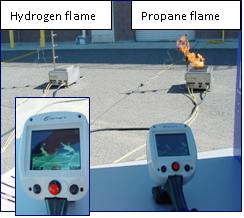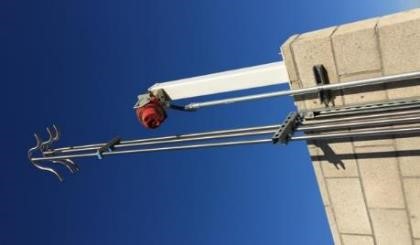Flame Detection
Burning H2 has pale blue flame that is nearly invisible in daylight. Hydrogen flames emit low radiant heat, so people may not feel the heat until they are very close to flame.
Permanently installed thermal and optical sensors can be used to detect hydrogen flames:
- To cover a large area or volume, many thermal detectors are needed and should be located at or near the site of a potential fire.
- Use listed or approved devices.
- Hydrogen-specific multiband infrared (IR) detectors are the least likely to be susceptible to false trips.
- Thermal (heat) detectors should respond to a specific temperature or rate of temperature change (NFPA 72 National Fire Alarm and Signaling Code).
Flame detectors are required in applications such as hydrogen fueling station dispensers (NFPA 52 Vehicular Natural Gas Fuel Systems). Detector systems should:
- Provide rapid and reliable flame indication
- Provide automatic shutoff and isolation of the hydrogen source
- Shut down the system to a safe mode
- Activate audible and visual alarms
- When applicable, increase active ventilation
- Require manual reset to restart
For detecting flames in areas where flame detectors are not permanently installed:
- Use a portable flame detector (e.g., thermal imaging camera) if available
- Listen for venting gas and watch for thermal waves that signal the presence of a flame.
- Use a combustible probe made of materials that will easily ignite if they contact a flame (e.g., a broom)
References
G-095, ANSI/AIAA Guide to Safety of Hydrogen and Hydrogen Systems
NFPA 52, Vehicular Natural Gas Fuel Systems Code
NFPA 55, Standard for the Storage, Use, and Handling of Compressed Gases and Cryogenic Fluids in Portable and Stationary Containers, Cylinders, and Tanks
NFPA 72, National Fire Alarm and Signaling Code



